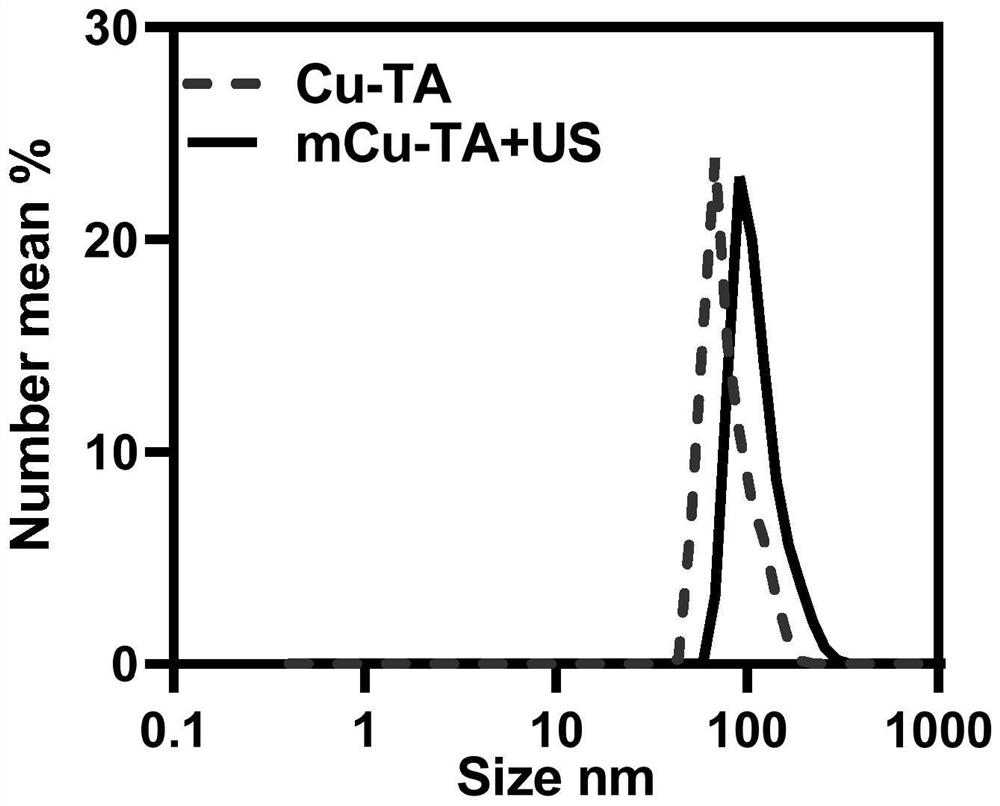Homologous targeting tannic acid copper albumin composite nanoparticle and preparation method and anti-tumor application thereof
A composite nanoparticle, nanoparticle technology, applied in homologous targeting copper albumin tannin composite nanoparticle and its preparation, application field of tumor treatment, can solve nanoparticle tumor targeting tumor microenvironment peroxidation Insufficient hydrogen content and other problems, to achieve good tumor targeting, enhance anti-tumor effect, and increase anti-tumor effect
- Summary
- Abstract
- Description
- Claims
- Application Information
AI Technical Summary
Problems solved by technology
Method used
Image
Examples
Embodiment 1
[0046] The extraction of embodiment 1 cancer cell membrane
[0047] Collect the MDA-MB-231 breast cancer cells in a 10cm culture dish, centrifuge at 1000rpm for 4min, collect the pelleted cells, then add 1mL neutral lysate (containing protease inhibitors) to the pelleted cells, 1~1.5mL / tube, place in an ice bath 20min. Then it was further ultrasonicated for 30s in ice bath protection (power 20% super 2s stop 2s). The sonicated cell suspension was centrifuged at 3200 g for 5 min, and the supernatant was taken. Finally, the above supernatant was further centrifuged at 4° C. and 20,000 g for 20 min under the condition of high-speed centrifugation, and the supernatant was collected to obtain a cell membrane suspension.
Embodiment 2
[0048] Example 2 Preparation of homologous targeting copper tannate human serum albumin composite nanoparticles
[0049] Weigh 20 mg of human serum albumin, dissolve 5 mg of glucose oxidase in 2 mL of deionized water, and mix with human serum albumin evenly. Add 100 μL of chloroform, and under the protection of an ice bath, perform intermittent ultrasonication for 5 minutes to remove the organic solvent and obtain a nanocomposite system; add 200 μL of 0.1 M sodium carbonate aqueous solution, and ultrasonically clean the solution for 5 minutes to obtain a transparent and clear nanoparticle aqueous solution. Add 10 μL of tannic acid (40 mg / mL) to 2 mL of the above nanoparticle solution, followed by 200 μL of CuCl 2 .2H 2 O (6.3mg / mL), continue stirring for 30min to obtain Cu-TA nanoparticles. Finally, the prepared cell membrane solution was added and passed through a 220nm filter 10 times by a film extrusion method to obtain the homologously targeted copper tannate human serum...
Embodiment 3
[0050] Example 3 In different concentrations of hydrogen peroxide, the detection of composite nanoparticles producing ROS in aqueous solution
[0051] Under dark light conditions, 4 μL of 10 μM 2′,7′-dichlorofluorescein diacetate was added to 2 mL of the composite nanoparticles obtained in Example 2 containing different hydrogen peroxide concentrations (0 mM, 10 mM, 50 mM, 100 mM) (DCFH-DA) fluorescent probe, after diluting a certain number of times, detect the fluorescence intensity of active oxygen with a multifunctional microplate reader, and obtain the active oxygen concentration after the reaction. The results are as follows: image 3 As shown, the reactive oxygen species produced by the nanoparticles are positively correlated with the concentration of hydrogen peroxide, and the reactive oxygen species increase with the increase of hydrogen peroxide, which can achieve a highly efficient Fenton-like reaction effect.
PUM
| Property | Measurement | Unit |
|---|---|---|
| particle diameter | aaaaa | aaaaa |
Abstract
Description
Claims
Application Information
 Login to View More
Login to View More - R&D
- Intellectual Property
- Life Sciences
- Materials
- Tech Scout
- Unparalleled Data Quality
- Higher Quality Content
- 60% Fewer Hallucinations
Browse by: Latest US Patents, China's latest patents, Technical Efficacy Thesaurus, Application Domain, Technology Topic, Popular Technical Reports.
© 2025 PatSnap. All rights reserved.Legal|Privacy policy|Modern Slavery Act Transparency Statement|Sitemap|About US| Contact US: help@patsnap.com



